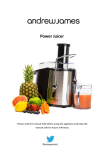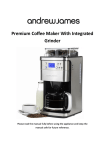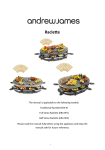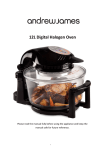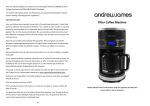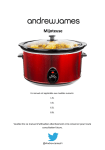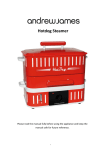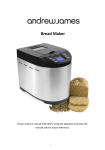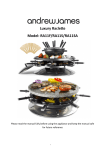Download Andrew James Domestic Vacuum Sealer Operating instructions
Transcript
Pro Vacuum Sealer Please read the manual fully before using the appliance and keep the manual safe for future reference. 1 Contents page Important safeguards Page 3 Functions and features Page 5 Cutting bag roll into small sachets Page 6 Present food with the bag Page 6 Vacuum package unit canister Page 8 Operating instructions Page 9 Hints for best vacuuming performance Page 11 Cleaning and maintenance Page 12 Vacuum package guidelines Page 14 Troubleshooting Page 15 Disposal of the appliance Page 16 UK & EU Guarantee Page 17 Electrical information Page 18 2 Important safeguards When using any electrical appliance, basic safety precautions should always be followed including: This appliance can be used by children aged from 8 years and above and persons with reduced physical, sensory or mental capabilities or lack of experience and knowledge if they have been given supervision or instruction concerning use of the appliance in a safe way and understand the hazards involved. Children shall not play with the appliance. Cleaning and user maintenance shall not be made by children unless they are older than 8 and supervised. Keep the appliance and its cord out of reach of children less than 8 years old. Always ensure the voltage on the rating label corresponds to the voltage in your home. Check the power cord and plug regularly for any damage. If the cord or the plug is damaged, it must be replaced by a qualified electrician or a service repair centre. If in doubt please contact our customer service team. The appliance is intended for domestic use only. Industrial or commercial use will void the warranty. The supplier cannot be held responsible for injury or damage if the appliance has been used for anything other than its intended use. Incorrect operation and use can damage the appliance and cause injury to the user. Do not use the appliance if it has been dropped or damaged in anyway. If the unit has been damaged take the unit for examination and or repair by and authorised service agent. Do not immerse or expose the motor assembly, plug or the power cord in water or any other liquid for any reason. If the supply cord is damaged, it must be replaced by the manufacturer or by someone who is suitably qualified to avoid a potential hazard. Do not let the cord hang over the edge of a table or counter. Ensure that the cord is not in a position where it can be pulled or tripped over accidentally. 3 Do not allow the cord to touch hot surfaces and do not place the cord near hot gas or electric burners or in a heated oven. Use of an extension cord with this appliance is not recommended. However if it is necessary to use an extension cord, ensure that the extension cord is equal to or greater than the power consumption of the appliance to avoid overheating of the appliance and extension cord. Do not use any other appliance on the extension cord. Do not place the extension cord in a position where it can be pulled on by children or animals or be tripped over. Always operate the appliance on a smooth, even and stable surface. Do not place the unit on a hot surface. Always remove the plug of the appliance safely. Do not pull on the appliances cord to remove the appliance plug from the electrical socket. Never handle or operate the appliance with wet hands. Do not use the appliance if it has fallen or if it appears to be damaged. When the appliance is switched “on” or in a working position, always make sure it is on a stable surface, such as a table or counter. There is no need to use any lubricant, such as lubricating oils or water on this appliance. Do not use this appliance outdoors or on a wet surface, its recommended for household, indoor use only. 4 Functions and features 1.Bag Cutter Used for bag roll cutting 2. Cancel button Stop working at any time 3.Indicator light Shows the working status 4. Seal time According to food type to optimize the seal timenormal or extended 5. Jar Port To which the adaptor is connected 6. Release button Press to release the front cover from base as well as release air. 7. Seal only Button Used for bags sealing only 8. Vacuum/ Seal button Used for vacuuming and sealing bags 9. Canister only button Used for vacuum canister only (canisters sold separately 10. Roll storage compartment Store bag roll handy for the greatest packaging convenience 11. Sealing stripe Heated part for bag sealing 12. Upper gasket Keep air away by forming vacuum environment with upper gasket 13. Hook Ensures the lids connected to the base 14. Lower gasket Keep air away by forming vacuum environment with upper gasket 15. Air intake The air outgoing when using vacuum canisters 16. Vacuum surface Draws air out of bag and catches any liquid overflow 17. Sealing profile Help to seal bag 2 1 5 7 8 9 6 11 10 13 12 14 5 4 3 16 17 15 Cutting bag roll into small sachets 1. Put the bag material to the suitable length you want ( Fig 1) Fig 1. 2. Close the lid and move the incision bottom from one end to the other (Fig 2) Fig 2. 6 Preserve food with the bag 1. Put the bag that contains food to the bottom of the air portal (Fig 3). Fig 3. 2. Close the upper lid and press tightly (Fig 4). Fig 4. 3. Press the Vacuum/Seal button (Fig 5). Fig 5. 4. Press down the release button till the lid opens automatically (Fig 6). Fig 6. 7 Vacuum package with canister (Canisters purchased separately at www.andrewjamesworldwide.com 1. After the lid is closed, connect the ends of the adaptor separately to the lid of the canister and jar port tightly as shown in the picture (Fig 7). Fig 7. 2. Press the canister button only, the appliance will vacuum and stop automatically (Fig 8). Fig 8. 3. Press the release button when you are finished vacuum sealing (Fig 9). Fig 9. 4. Store the adaptor and cord at the bottom as shown in the picture (Fig 10). Fig 10. 8 Operating instructions Making a bag with the bag roll 1. The bag cutter (1) must be positioned at either end of the cutter slide before cutting. 2. Open the rear lid and place the bag roll into the roll storage compartment (10). 3. Pull the bag material out of the storage compartment (10) to the suitable length you want and then close the rear lid. 4. Press and slide the bag cutter (1) from one side to the end, pull the bag gently to achieve a better effect. 5. Open the upper lid and place either the open end of the bag material on the sealing strip (11), close it and hear two clicks will indicate the appliance is blocked. 6. Press the seal only button (7) to start sealing. 7. When the seal indicator light (3) turns, sealing is completed. 8. Open the upper lid and take out the bag. 9. Now the bag is ready. Note: The appliance cannot work with bag rolls wider than 30cm. Preserve food with the bag: 1. Place the food inside the bag 2. Open the upper lid, clean and straighten the open end of the bag, ensure no wrinkles or ripples are present. 3. Place both panels of the bag on the removable interface (16) below the air intake (15) . 4. Close the lid and then press heavily on both sides of the lid until two click sounds can be heard. 5. Press the vacuum/seal button (8) then the bag will automatically be vacuumed and seal. 9 6. When the indicator lights of seal only and seal/vacuum turn off, the process is completed. Press the two release buttons (6), lift the lid and remove the bag. 7. Refrigerate or freeze if needed. Note: For best sealing effect, it is best to let the appliance cool down for one minute before using it again. Wipe away any excess liquid or food residue on the removable interface after each bag package. Open a sealed bag Cut bag straight with scissors, just inside the sealing line. Resealing You can reseal many foods in their original store packages (i.e. potato chip bags) follow steps of “preserve food with bag”. Vacuum package with canister (Canisters purchased separately at www.andrewjamesworldwide.com 1. Wipe the canister cover and the canister base and ensure they are clean and dry. 2. Put the food you want to preserve into the canister and leave at least one inch of space from the food and cover rim. 3. Place the cover on the canister; insert one end of the accessory hose into the port of the appliance. Put the other end “vacuum suck tray” on the canister lid and make sure the vacuum suck tray is completely covered by the lid knob switch. 4. Close the upper lid. 5. Press the canister only button (9), the motor will start to run to vacuum. 6. When the indicator light of the canister only (3) turns off, the vacuum process is complete; then gently twist and pull up the accessory hose of the appliance. Note: To simply test the vacuum when the process has completed, grasp the hose and lift the canister, the canister cover will not depart. 10 Open canister after vacuum packaging In order to open the canister, you need to release the vacuum by turning the knob switch clockwise to the max position. Hints for best vacuuming performance: 1. Do not put too much food inside the bag: leave enough space at the open end of the bag so that the bag can be placed on the removable interface more positively . 2. Do not wet the open end of the bag. Wet bags may be difficult to melt and seal tightly. 3. Clean and straighten the open end of the bag before sealing. Make sure nothing is left on the open area of the bag, no wrinkles or creased lines appear on the open panels; foreign objects or a creased bag may cause difficulty when sealing . 4. Do not vacuum pack objects with sharp points like fish bones or hard shells. (Sharp points may penetrate and tear the bag). 5. Fill a bag about 2/3 full with water; seal the end (don't vacuum). Freeze the bag and use for ice in the cooler, or ice packs for sport injuries. 6. Allow the appliance to cool down for 1 minute before re-using the appliance. 7. Pre-freeze fruits and blanch vegetables before vacuum packaging for best results. 8. During bag vacuum packaging process, small amounts of liquids, crumbs or food particles can be inadvertently pulled into removable interface, clogging the pump and damaging your appliance. To prevent this follow these tips:# A) For moist and juicy foods such as raw meats, Freeze first and avoid overfilling bags, you can also place a folded paper towel inside the top of the bag, but below seal area before vacuum packaging. B) for soups , sauces and liquids: freeze first and then vacuum. Keep the vacuum bag or canister with the food in a refrigerator. C) for powdery or fine-grained foods: avoid overfilling bags or use a canister. You can also place a coffee filter or paper towel inside before vacuum packaging. 11 Vacuum packaging non-food items The vacuum preservation system also protects non-food items from oxidation, corrosion and moisture. Simply follow the directions to vacuum package items using bag or canister. 1. To vacuum package items ensure that sharp edges are cushioned in soft material, such as a paper towels, to avoid puncturing bag. 2. The appliance can keep camping supplies such as matches, first aid kits and clothing clean and dry. Keep flares for auto emergencies ready. 3. Also keep batteries, candles, film, photos, nuts, bolts, screw and anything you want to stay dry. Cleaning and maintenance Vacuum preservation system Always unplug the unit before cleaning. Do not immerse appliance in water or any other liquid. Do not use abrasive cleaners to clean the unit, for they will possibly scratch the surface. Wipe the outside of the unit with a damp cloth, sponge or mild dish soap. Wipe away food residues and water inside or around the components with a paper towel. Dry thoroughly before using it again. Note: The airproof loop of sponge should be dried thoroughly before re-assembling. When re-assembling, be careful to prevent any damage and assemble as original position to ensure no vacuum leaking Preservation bags 1. Wash bag material in warm water with a mild detergent. 2. Bags can be washed on the top rack in your dishwasher by turning the bag inside out. Stand bags up so that the washing water can rinse the entire surface. 12 3. Make sure that the bags are thoroughly dry before using. Accessories (including canister base, cover and hose accessories). 1. Wash all vacuum accessories in warm water with a mild detergent, but do not immerse the cover in water. 2. Canister bases (not lids) are top rack dishwasher safe. But canister cover should be wipe down with a damp cloth. 3. Ensure the accessories are dried thoroughly before re-using. 4. Canister and cover are not suitable for use in microwave but suitable for freezer. Storing your vacuum preservation system Keep the unit in a flat and safe place, out of the reach of children. Ensure that the upper lid of the appliance is unlocked when it is not in use and in storage. 13 Vacuum package guidelines Vacuum sealing for the refrigerator For the busy family, on-the-go meals can be prepared ahead and vacuum-sealed in individual servings, ready to heat anytime. Preparing food for the freezer 1. In properly stored conditions, the vacuum sealer helps you to maintain the food’s freshness. Try to start with the freshest food possible. 2. Freeze foods which need to hold their shape or are fragile in nature, then vacuum seal in a vacuum bag and return to freezer. Food such as meats, berries and breads to avoid freezer burn. 3. To vacuum seal liquid-based foods, such as soups, casseroles or stews, first freeze in a baking pan or tempered dish, vacuum seal, label and stack in your freezer as soon as they are frozen solid. 4. Blanch the vegetables by cooking them briefly in boiling water or microwaving them, allow them to cool down, then vacuum seal in convenient portions. 5. To vacuum seal the foods that are not frozen, allow two extra inches of bag length to allow for expansion while freezing. Place the meat or fish on a paper towel, and vacuum seal with the paper towel in the bag, this will help to absorb moisture from the foods. 6. Before storing the foods such as tortillas, crepes or hamburger patties, use wax or parchment paper between them to stack the pieces, this makes it convenient to remove some of the food, reseal the rest and immediately place them in the freezer. 14 Troubleshooting Nothing happens when you press the vacuum sealer. 1. Make sure the power cord is correctly plugged into the electrical outlet and in the “On” position. Test electrical outlet by plugging in another appliance and seeing if it works. 2. Check the power cord for any damage, if it is damaged do not use the vacuum sealer. Air has not been removed from the bag completely 1. To seal properly, the open end of the bag should be resting entirely inside the vacuum channel area. 2. Check the sealing strip and gasket beneath the lid for debris and position. Wipe it clean and smooth them back into place. 3. The bag may have a hole. To test, seal the bag with some air in it, submerge in water and apply some pressure. If there are bubbles present, it indicates a hole in the bag. 4. Check to see if the lid is completely latched into place. Vacuum sealer bag loses vacuum after being sealed. 1. Wrinkles, crumbs, grease or liquids may cause leaks along the seal. Re-open the bag, wipe the top of the inside of the bag and smooth it out along the sealing strip before resealing. 2. Check if there is moisture of juices from the food is present within the bag, if so you may need to cut open the bag and reseal it or use a new bag. 3. If the items have sharp edges, they may have been punctured by the bad and released there vacuum. Cushion sharp edges of the object with a paper towel. 15 Disposal of the appliance THIS PRODUCT IS FOR HOUSEHOLD USE ONLY! Correct disposal of this product This marking indicates that this product should not be disposed with other household wastes throughout the EU. To prevent possible harm to the environment or human health from uncontrolled waste disposal, recycle it responsibly to promote the sustainable reuse of material resources. To return your used device, please use the return and collection systems or contact the retailer where the product was purchased. They can take this product for environmental safe recycling. Your new product has a warranty of 12 months from the date of consumer purchase. Please keep your receipt or order number as it will be required as proof of date of purchase. This warranty only applies if the item has been used solely for household use and all instructions have been followed properly. Abuse of your appliance will invalidate the warranty. Returned goods cannot be accepted unless repacked properly within the original colour box and presented with the original receipt or order confirmation. This does not affect your statutory rights. 16 UK and EU Guarantee Your new Andrew James product comes with a 24 month guarantee and a 2 year fixed warranty, effective from receipt confirmation. Your receipt or order number is required as proof of purchase date so it is imperative that you keep it safe. This guarantee only applies if the item has been used solely for the use intended, and all instructions have been followed accordingly. Please note this product is only for domestic use only and is not for commercial use. Abuse of your product will invalidate the guarantee. Returned goods can only be accepted if repackaged properly within the original colour product box, and presented with the original receipt of sale/order number. This does not affect your statutory rights. Returned products must be cleaned and returned to us in as close to delivery condition as possible. If your product develops a problem within the first 12 months of the fixed warranty, we will pay all shipping costs to have it returned to us. After 12 months the customer will be liable for the cost of returning the product to us. We will then pay to have the repaired/replaced item shipped back to the customer. If you wish to return your item for a full refund, you have the right to do so within the first 7 days. For our returns policy please go to www.andrewjamesworldwide.com Customers are responsible for any taxes applied to our products when they are shipped outside of the EU. All of our prices are inclusive of VAT. Once a product has been returned to us, we will aim to repair or replace it within 30 days of receipt. The guarantee does not cover any defect arising from improper use, damage, buildup of lime scale or repair attempts made by third-parties. Also, the guarantee does not cover normal wear and tear of individual parts. 17 Electrical Plug Information Please note: It is extremely important that the wires or cores in the flex are connected to the correct terminals in the plug. If the colour of the mains lead of the appliance does not correspond with the coloured markings identifying the terminals in your plug proceed as follows: The Live (Brown) wire connects to the rightmost live (L) terminal nearest to the fuse. The Neutral (Blue) wire connects to the leftmost neutral (N) terminal. The Earth (Green and Yellow) wire connects to the central, top most earthed (E) terminal. Warning: If the appliance is double insulated indicated by the double insulated symbol: it should not have an earth wire or earth connection. Plug The plug must be protected by the correct AMP fuse; this will be indicated on the case of the plug. Only BSI or ASTA approved fuses should be used. When changing the fuse always replace it with a fuse that is of the same identical rating as the original. If you are unsure about which plug or fuse to use, always refer to a qualified electrician. Please note after replacing the fuse, ensure that the cover is correctly fitted back 18 onto the plug. Never attempt to run the appliance if the plug does not have a cover. If a moulded plug is fitted and has to be removed take great care in disposing of the plug and severed cable, it must be destroyed to prevent it from engaging into a socket. If the supply cord is damaged it must be replaced by a service agent or a similarly qualified person in order to avoid a hazard. All of our electrical appliances conform to pre-existing EC Directives 2006/95/EC (Low Voltage Directive) and 2004/108/EC (EMC Directives). For further information please visit http://www.esc.org.uk/industry/productsafety/product-testing-screening/kitchen-appliances/ Copyright Andrew James 19





















